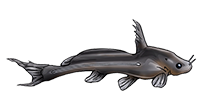Small Pleco for warm water??
-
harsmann
- Posts: 25
- Joined: 10 Nov 2005, 12:56
- I've donated: $10.00!
- Location 1: Copenhagen, Denmark
Small Pleco for warm water??
Hi,
I am looking for an algae-eating pleco that will do well in an 85L/22Gl tank with temperature 28-30°C, pH 7.5, GH 18-20. Any recommendations?
Tank mates will be a pair of rams (hence the high temperature), some peaceful tetras and maybe a small school of C. sterbai.
Thanks,
Allan
I am looking for an algae-eating pleco that will do well in an 85L/22Gl tank with temperature 28-30°C, pH 7.5, GH 18-20. Any recommendations?
Tank mates will be a pair of rams (hence the high temperature), some peaceful tetras and maybe a small school of C. sterbai.
Thanks,
Allan
- Chrysichthys
- Posts: 1331
- Joined: 09 Jan 2003, 17:22
- My images: 1
- My cats species list: 43 (i:0, k:0)
- Spotted: 1
- Location 1: Oxford U.K.
- Interests: catfish!
-
harsmann
- Posts: 25
- Joined: 10 Nov 2005, 12:56
- I've donated: $10.00!
- Location 1: Copenhagen, Denmark
A pair of bristlenoses would be fun, I am just worried about the temperature.
The bristlenoses I can get in my area are problably Ancistrus sp(3) (but sold as A. dolichopterus). According to the Cat-elog they prefer the temperature range 22-24° (though I have seen both 23-27° and 23-29°C in other references).
I have a bristlenose in another tank - I could start by moving her over to see how she manages. It would be fun getting a date for her.
- Allan
The bristlenoses I can get in my area are problably Ancistrus sp(3) (but sold as A. dolichopterus). According to the Cat-elog they prefer the temperature range 22-24° (though I have seen both 23-27° and 23-29°C in other references).
I have a bristlenose in another tank - I could start by moving her over to see how she manages. It would be fun getting a date for her.
- Allan
-
Mike_Noren
- Posts: 1395
- Joined: 25 Jul 2003, 21:40
- I've donated: $30.00!
- My articles: 1
- My images: 37
- My cats species list: 5 (i:0, k:0)
- Spotted: 9
- Location 1: Sweden
- Location 2: Sweden
Common ancistrus will do perfectly, and breed enthusiastically, at that temperature. No worries.
Other commonly available options include the smaller Otocinclus and Parotocinclus-species, although especially the otos are considerably more sensitive and harder to keep alive (never mind breed!) than common ancistrus.
Other commonly available options include the smaller Otocinclus and Parotocinclus-species, although especially the otos are considerably more sensitive and harder to keep alive (never mind breed!) than common ancistrus.
-
harsmann
- Posts: 25
- Joined: 10 Nov 2005, 12:56
- I've donated: $10.00!
- Location 1: Copenhagen, Denmark




